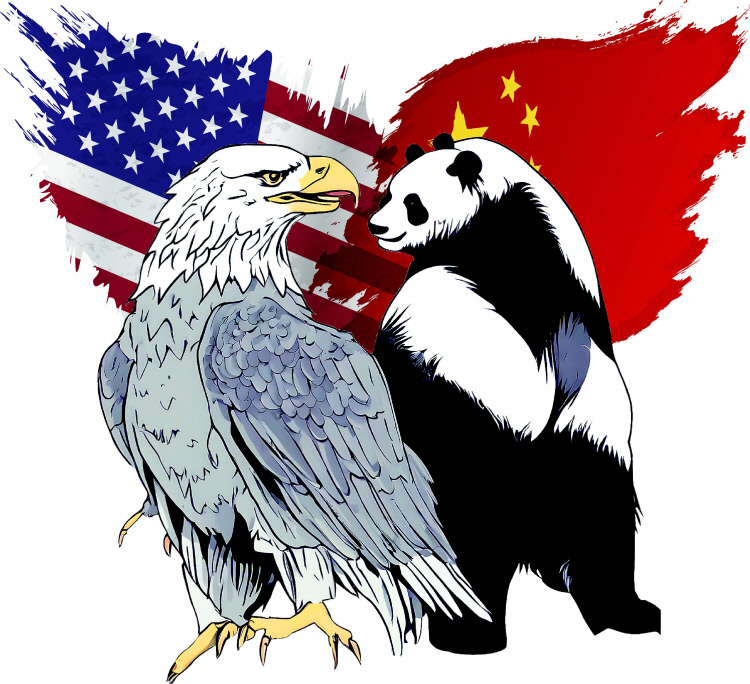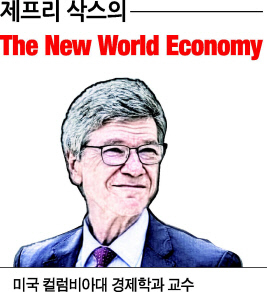

The latest campaign of the United States against China is the charge that China has excess capacity in a range of manufactured goods and so should restrain its exports. The truth is simpler. China and other countries of East Asia are the world‘s low-cost producers of a range of high-quality industrial products that the world urgently needs: solar modules, electric vehicles, wind turbines, efficient batteries, 5G and more. Since the US lags behind China in these sectors, the US is bad-mouthing China, characterizing China’s success as some kind of alleged bad behavior.
The US approach to China is based on a mix of arrogance, nastiness, and naivete. The arrogance is that the US runs the world, so how dare China have such economic success! The nastiness is that the US is actively out to hinder China‘s progress.
Progress in our world is hard enough without the US working against it in other countries.The naivete is to believe that the rest of the world will actually subscribe to the US propaganda.
 |
| Ambassador Robert Blackwill and Ashley Tellis''s publication for the Council on Foreign Relations. It includes U.S.Grand Strategy toward China. |
The arrogance was spelled out in 2015 by Ambassador Robert Blackwill and Ashley Tellis in a publication for the Council on Foreign Relations. In March 2015, they wrote: “Since its founding, the United States has consistently pursued a grand strategy focused on acquiring and maintaining preeminent power over various rivals, first on the North American continent, then in the Western hemisphere, and finally globally.”
“Because the American effort to ‘integrate’ China into the liberal international order has now generated new threats to U.S. primacy in Asia...and could eventually result in a consequential challenge to American power globally...Washington needs a new grand strategy toward China that centers on balancing the rise of Chinese power rather than continuing to assist its ascendancy.” Plainly put, America‘s aim is to be Number 1. America’s “grand strategy” is not peace, sustainable development, or wellbeing, but hegemony. America has chosen a grand strategy that automatically pits it against other major powers in a zero-sum struggle. For American strategists, international cooperation is naïve since the US goal is dominance. It‘s a vain and ultimately doomed objective. After all, the US has 335 million people while China has 1.4 billion people, or roughly four times more. How is the US to remain dominant when China is four times more populous?

The American answer implicitly is to keep China in relative poverty, with a GDP no more than one-fourth of the US level. But rest assured that China will not be hegemon either. China’s share of world output will peak at around 20 percent, and China will face significant challenges of a declining and aging population during the 21st century. The nasty part of the US‘s strategy follows its misguided attempt to be global hegemon. The US goal is to slow, if not derail, China’s economic success. Blackwill and Tellis spelled out the game plan in their 2015 article. The US tactics include: trying to cut China out of trade agreements; trying to cut China out from high-tech goods such as advanced semiconductors;surrounding China militarily on the Asian rimlands; and forging new military alliances in Asia. President Barack Obama started the process by trying to negotiate the Trans-Pacific Partnership, based on the absurd idea of creating a US-Asia trading arrangement that excluded China, despite China being the largest trade partner of most or all of the other Asian countries.
It was a dumb idea, and it mercifully failed. Trump was more direct. He hit China over the head with a spate of unilateral tariff increases that plainly and brazenly violated the WTO. To sustain this protectionism, the US simply walked away from WTO enforcement mechanisms, to the extent of paralyzing the WTO appellate procedures. When Biden came to office, he not only kept Trump‘s tariffs in place, but doubled down on them, introducing new layers of protectionism in American legislation (for example in the Inflation Reduction Act) and new layers of technology export bans, notably on advanced semiconductors but also other technologies.
Both Trump and Biden went after Huawei, China’s very innovative and extremely efficient private-sector producer of advanced digital technologies, including 5G and several cutting-edge digital industry platforms. America‘s “success” is to have partly closed off its market to China’s highly competitive, low-cost, high-quality goods. China‘s exports to the US markets not only stopped growing, but actually went into decline. Measured as a share of US GDP, US imports from China fell from 2.6% of GDP in 2018 to 1.6% of GDP in 2023.
Yet this has raised prices to US consumers and companies, and brought no joy to American workers. The US manufacturing workforce at around 13 million workers is only slightly higher than in 2017, and remains far lower than before the 2008 Great Recession. We also learned something quite astounding―but actually par for the course―recently, when Reuters revealed that Trump had tasked the CIA with spreading malicious gossip about China in the social media, including badmouthing of China‘s Belt and Road Initiative. When you can’t beat ‘em honestly, beat ’em dishonestly. The American way, alas. So, the US has partly closed its markets to China‘s good and wants Europe to do the same. Since China’s productive capacity continues to rise, there is indeed an artificially created “excess capacity” in China, because the US has blocked China‘s exports to the US. Now, the US is warning China against selling its goods to other markets as well. Here‘s a vastly better and more honest approach. First, the US should acknowledge that it fell far behind China (including Taiwan), Korea, and Japan, in many areas of advanced manufacturing not because of nefariousness of those East Asian countries but because the US lost its way when it came to fostering green and 5G technologies.
| ||
| Chinese yuan and U.S. dollar notes. [Reuters] |
While the US has been clinging to the continued expansion of fossil fuel production, a real policy dead-end in a world that needs to decarbonize by mid-century, China has been preparing for the zero-carbon energy. Thus, China leads the world in solar, wind, 4th-generation nuclear, EVs, and many other technologies. Second, China does not have an “excess capacity” of manufacturing output, because China is producing what the world actually urgently needs to bring about environmental sustainability and economic development. The apparent glut is the result not only of US protectionism, but also of insufficient financing for sustainable development of the emerging economies.
The world doesn‘t need less of China’s output, it needs more finance to speed the energy transition and to end poverty. Third, the US should be cooperating with China, not fighting with it, when it comes to global sustainable development. China‘s Belt and Road Initiative (BRI), for example, is a highly innovative and important policy to promote sustainable development in the emerging economies. Rather than badmouthing the BRI, as the CIA did in its propaganda, the USG should be partnering with China, Korea, Japan, and others in a cooperative policy to promote more investments in green and digital technologies in the emerging economies around the world. That’s the kind of win-win policy that should replace America‘s destructive--and self-destructive--machinations for hegemony.


중국의 경쟁력과 미국식 험담
최근 미국은 여러 공산품에 대한 중국의 생산능력이 과잉이기 때문에 중국의 수출을 제한해야 한다고 주장하는 대중국 캠페인을 벌이고 있다. 진실은 이보다 더 단순하다. 중국과 여러 동아시아 국가들은 태양광 모듈, 전기차, 풍력 터빈, 배터리, 5G 등 세계가 긴급히 필요로 하는 다양한 고품질의 산업용 제품을 낮은 비용으로 생산하고 있다. 미국은 이러한 분야에서 중국에 뒤쳐져 있기 때문에 중국에 대한 험담을 하며 중국의 성공을 뭔가 안 좋은 것으로 묘사하고 있다.중국에 대한 미국의 이러한 접근방식에는 오만함과 고약함, 순진함이 섞여 있다. 미국이 세계를 지배하는데 어떻게 감히 중국이 경제적으로 성공할 수가 있냐는 태도는 오만하고, 중국의 발전을 방해하기 위해 적극적으로 나서고 있다는 점은 고약하다. 우리가 사는 세상에서 발전이란 미국의 방해 공작 없이도 충분히 이루기 힘든 것이기 때문이다. 마지막으로, 나머지 나라들이 미국의 정치적 선전에 실제 동참해 줄 것이라고 믿는 점은 순진하다.
미국의 오만함은 2015년 미국의 외교관인 로버트 블랙윌(Robert Blackwill)과 애슐리 텔리스(Ashley Tellis)가 작성한 미국외교협회의 보고서에서 분명히 드러난다. 2015년 3월 발표된 보고서에서 그들은 이렇게 말한다.“건국 이래로 미국은 다양한 라이벌 국가보다 더 현저한 힘을 획득하고 유지하는 데 초점을 맞춘 대(大)전략을, 처음에는 북미 대륙에서 그 다음엔 서반구에서 마지막으로는 전 세계에서 일관되게 추구해왔다.”
“중국을 자유주의 국제질서에 ‘통합’시키려는 미국의 노력이 현재 아시아에서 미국의 우위에 대한 새로운 위협을 야기하고 있고...궁극적으로는 전 세계에서 미국의 힘에 대한 도전이 제기되도록 할 수 있기 때문에...미국 정부는 중국의 부상을 계속 지원하기보다 커져가는 중국의 힘에 대한 균형을 잡는 데 중점을 둔 새로운 대(大)전략을 필요로 한다.”
간단히 말해 미국의 목표는 넘버원이 되는 것이다. 미국의 ‘대전략’은 평화나 지속가능한 발전, 안녕이 아니라 패권이다. 미국은 제로섬 투쟁에서 미국이 자동적으로 다른 강대국들과 대결하게 되는 대전략을 선택했다. 미국의 목표는 지배적인 우위를 차지하는 것이기 때문에 미국의 전략가들에게 국제 협력은 너무나 순진한 말이다.
이는 헛되고 궁극적으로는 실패할 게 뻔한 목표다. 미국은 인구가 3억3500만명인 반면 중국 인구는 대략 그 4배인 14억명이다. 중국이 인구가 4배나 더 많은데 어떻게 미국이 우세를 유지한다는 것일까? 이에 대한 미국의 암묵적인 해답은 중국을 GDP가 미국의 4분의 1도 되지 않는 상대적인 빈곤 상태로 유지하는 것이다. 그러나 중국도 패권국이 되지는 못할 테니 안심해도 된다. 세계 생산량에서 중국이 차지하는 비중은 약 20%에서 정점을 찍을 것이며, 중국은 21세기 동안 인구 감소와 인구 고령화라는 심각한 문제에 직면하게 될 것이다.
미국의 전략이 고약한 것은 세계 패권국이 되려는 미국의 잘못된 시도를 따라가고 있기 때문이다. 미국의 목표는 중국의 경제적 성공을 완전히 방해하지는 못하더라도 이를 가급적 늦추는 것이다. 블랙윌과 테릴스는 2015년 보고서에서 미국의 작전에 대해 자세히 밝혔다. 미국의 전술에는 무역 협정에서 중국 배제시키기, 최첨단 반도체 등 첨단 기술 제품에서 중국 배제시키기, 아시아 주변 국가들로 중국을 군사적으로 포위하기, 아시아에서 새로운 군사 동맹 구축하기 등이 포함된다.

이 작전이 시작된 것은 중국이 아시아 국가 중 미국의 가장 큰 무역 파트너라는 사실에도 불구하고 버락 오바마 대통령이 중국을 배제한 미국-아시아 무역 협정을 만들겠다는 터무니없는 계획을 기반으로 환태평양 경제 동반자 협정(TPP)에 대한 협상을 시도했을 때다. 이 바보 같은 계획은 다행히 실패했다.
트럼프는 더 직접적이었다. WTO 규정을 대놓고 위반하는 일련의 일방적인 관세 인상으로 중국을 정통으로 가격했다. 이 보호주의를 유지하기 위해 미국은 WTO 분쟁해결 매커니즘에서 사실상 그냥 나가버렸고, WTO 상소기구의 기능이 마비됐다.
바이든은 취임 후 트럼프의 관세를 유지했을 뿐 아니라 더욱 배가했다. 미국의 법률에서 보호주의가 한 층 더 강화됐고 (예컨대 인플레이션 감축법) 특히 첨단 반도체 및 기타 기술을 포함한 기술 수출 금지 조치가 강화됐다. 트럼프와 바이든 모두 5G 및 여러 최첨단 디지털 산업 플랫폼을 포함한 첨단 디지털 기술을 생산하는 매우 혁신적이고 효율적인 중국 민간 업체인 화웨이를 공격했다.

미국이 말하는 ‘성공’은 경쟁력 있는 중국의 저비용·고품질 제품에 대해 자국 시장을 부분적으로 폐쇄하는 것이었다. 대미 중국 수출은 성장이 멈췄고 이제 감소하기 시작했다. 미국 GDP에서 차지하는 비중으로 측정했을 때, 미국의 대중국 수입은 2018년 GDP의 2.6%에서 2023년 GDP의 1.6%로 감소했다. 그러나 이 조치는 미국의 물가를 인상시켰고 미국 노동자들에게도 좋은 결과를 가져오지 못했다. 약 1300만명 수준인 미국 제조업 인력은 2017년에 비해 약간 늘어났을 뿐이며, 2008년 대침체 이전보다는 여전히 훨씬 낮은 수준에 머무르고 있다. 또한 최근 로이터통신이 트럼프가 CIA에게 중국의 일대일로 계획에 대한 비난을 포함해 중국에 대해 악의적인 소문을 퍼뜨리는 임무를 맡겼다고 소셜 미디어에 밝혔을 때, 우리는 꽤 놀랍지만 당연한 사실을 알게 됐다. 정직하게 이길 수 없다면, 정직하지 못하게 이겨라. 참으로 미국적인 방식이다.
미국은 중국 제품으로부터 부분적으로 자국 시장을 닫았고, 유럽도 그렇게 하기를 원하고 있다. 중국의 생산능력이 계속해서 증가하는 상황에서 중국에는 인위적으로 만들어진 ‘생산능력 과잉’ 문제가 존재하긴 하는데, 이것은 미국이 중국 제품의 미국 수출을 막았기 때문이다. 이제 미국은 중국 제품을 다른 시장에도 판매하지 말라고 중국에게 경고하고 있다.

여기 훨씬 더 정직하고 더 나은 접근방식이 있다. 첫째, 미국은 동아시아 국가들의 부도덕함 때문이 아니라 친환경 및 5G 기술 개발에 있어서 미국이 길을 잃었기 때문에 많은 첨단 제조업 분야에서 (대만을 포함한) 중국, 한국, 일본에 뒤쳐졌다는 사실을 인정해야 한다. 미국이 지속적인 화석 연료 생산 확대에 매달리고 있던 동안 (21세기 중반까지 탈탄소화를 달성해야 하는 세계에서 이는 사실 막다른 길로 가는 정책이었다) 중국은 탄소제로 에너지를 준비해 왔다. 그 결과, 중국은 태양광, 풍력, 4세대 원자력, 전기차 및 기타 다양한 기술에서 세계를 선도하고 있다.
둘째, 중국은 환경적 지속가능성과 경제 발전을 위해 세계가 실제로 시급히 필요로 하는 것들을 생산하고 있는 것이기 때문에 중국은 제조업 생산량에서 ‘생산능력 과잉’ 문제가 없다. 지금 과잉으로 보이는 이유는 미국 보호주의의 결과일 뿐 아니라 신흥 경제국의 지속가능한 개발을 위한 자금 조달이 부족하기 때문이기도 하다. 세계는 중국의 생산이 덜 필요한 게 아니라, 에너지 전환을 가속화하고 빈곤을 종식시키기 위한 자금이 더 필요하다.
셋째, 전 세계의 지속가능한 발전을 위해 미국은 중국과 싸울 것이 아니라 협력해야 한다. 예를 들어, 중국의 일대일로 계획은 신흥 경제국의 지속가능한 발전을 촉진하기 위한 매우 혁신적이고 중요한 정책이다. CIA에 시켰던 것처럼 일대일로 정책을 욕하기보다 미국은 전 세계 신흥 경제국에서 친환경 및 디지털 기술에 대한 더 많은 투자가 이뤄지도록 장려하는 협력적인 정책을 통해 중국, 한국, 일본 및 다른 국가들과 협력해야 한다. 바로 이것이 패권을 잡기 위한 미국의 (자기) 파괴적인 계략을 대체할 윈윈 정책이다.
hongi@heraldcorp.com







